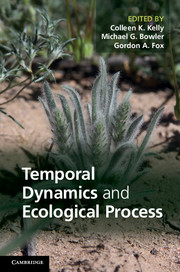Book contents
- Frontmatter
- Contents
- List of Contributors
- 1 Introduction
- Part I Observing temporal processes in nature
- 2 The storage effect: definition and tests in two plant communities
- 3 What temporal processes in trees tell us about competition, community structure and speciation
- 4 Testing the storage effect with long-term observational data
- 5 Seedling herbivory and the temporal niche
- 6 Temporal variation in density dependence in an herbaceous community
- 7 Population and community dynamics in variable environments: the desert annual system
- 8 Temporal niches, ecosystem function and climate change
- Part II Application to specific questions
- Index
- References
2 - The storage effect: definition and tests in two plant communities
Published online by Cambridge University Press: 18 December 2013
- Frontmatter
- Contents
- List of Contributors
- 1 Introduction
- Part I Observing temporal processes in nature
- 2 The storage effect: definition and tests in two plant communities
- 3 What temporal processes in trees tell us about competition, community structure and speciation
- 4 Testing the storage effect with long-term observational data
- 5 Seedling herbivory and the temporal niche
- 6 Temporal variation in density dependence in an herbaceous community
- 7 Population and community dynamics in variable environments: the desert annual system
- 8 Temporal niches, ecosystem function and climate change
- Part II Application to specific questions
- Index
- References
Summary
Introduction
Nature is pervaded by variation: the physical environment is ever changing in time and in space, populations fluctuate, and no two organisms are the same. To explore natural environments is to be confronted by variation, and the science of ecology is challenged by the persistent question: is this variation more than variation itself? Environmental variation can cause population fluctuations (Ripa et al. 1998), but can it do more than this? Does it affect how organisms interact with one another? Does it shape populations and communities? How and in what ways? Biologists firmly accept that variation shapes the organisms. Heritable variation is the engine of evolution, which is fuelled by environmental change. In life-history theory, it is widely accepted that organisms show adaptations to variation in the physical environment, exemplified by evolutionary theories of iteroparity and seed dormancy (Cohen 1966, Bulmer 1985, Ellner 1985a, Real and Ellner 1992). Fundamentally, these adaptations allow species to take advantage of favourable environmental conditions without being too vulnerable to unfavourable environmental conditions.
Community ecologists have had a variety of attitudes to variation, especially variation in the physical environment (Chesson and Case 1986). Successional change after disturbance had a prominent role in the early development of plant and ecosystem ecology (Clements 1916) and now has an important role in diversity maintenance theory relying on competition–colonisation tradeoffs (Hastings 1980). Spatial variation is often assumed to provide for, and should therefore promote, species diversity (Pacala and Tilman 1994, Amarasekare and Nisbet 2001, Snyder and Chesson 2004). Although it is often assumed that regular temporal variation, such as seasonal and diurnal variation, provides for temporal niches (Armstrong and McGehee 1976, Levins 1979, Brown 1989a, b, Chesson et al. 2001), there is also much unpredictable temporal variation, such as deviations of weather and climate from seasonal averages (Davis 1986) and disturbances such as fire (Connell 1978, Bond and Keeley 2005). Should we think of this unpredictable temporal variation as disruptive to ecological processes (May 1974)? Do organisms fail to adapt to unpredictable temporal variation? Are they merely jerked around by it? Life-history theory suggests otherwise (Bulmer 1985, Real and Ellner 1992), yet conclusions are often drawn from models that reflect no such adaptations, for example Lotka–Volterra models with unpredictable environmental variation added arbitrarily (Turelli 1981, Kilpatrick and Ives 2003).
- Type
- Chapter
- Information
- Temporal Dynamics and Ecological Process , pp. 11 - 40Publisher: Cambridge University PressPrint publication year: 2014
References
- 10
- Cited by



